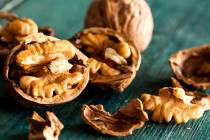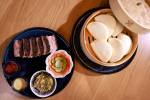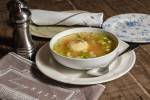Don’t Fear the Fish
Paul Bartolotta blames it on those school-cafeteria frozen fish fillets.
"If I've heard it once, I've heard it 100 times," he said. "I think every kid had bad fish."
Bartolotta, executive chef of Bartolotta Ristorante di Mare at Wynn Las Vegas, usually sees the manifestation of bad-fish history among large parties that come in and consider a tasting menu for the table.
"There's that one person who's kind of like ..." Bartolotta said, trailing off. "You can see it in their face that they're kind of intimidated.
"We end up getting them to try things. I have had people come back or write me letters or send me an e-mail saying, wow, I've really changed their lives. They thought they hated seafood."
So let today, the first day of Lent, be a new beginning for those of you with a fear of the fin fish and the shellfish. First of all, let's dispel the notion that fish taste ... well, fishy.
"If you walk into the fish section and it smells fishy, that's probably not a good sign," Bartolotta said.
"Fish should not have a fishy odor," said Stephen Hopcraft, executive chef of Seablue at MGM Grand. "It should smell clean, like the ocean."
Bartolotta said if the fish's head is on, there should be clarity in its eyes; "you should be able to look into the eye and see the ocean." The eyes shouldn't be sunken, or scales falling off, or the fins or tail appearing dried out.
But Hopcraft noted that these days -- and especially in a city with a decided shortage of fish markets -- most fish is purchased without the head. It's still easy, he said, to ensure that it's fresh.
"Without even touching the fish, have the butcher or person who's about to sell you the fish put his finger on the fillet and gently press in," he said. "If it's a fresh fish, it's going to bounce back very quickly."
Jason Talbott, executive chef at McCormick & Schmick's, said you shouldn't be afraid of asking to see, smell and touch the fish you're considering buying.
If the fish is frozen, Hopcraft said, "your nose can be fooled." In that case, he said, have the seller turn the fish over to "the side they're not going to be showing you" and look at the blood line on the back of the fish, down the middle near the spine. That should be as close to a rich red color as possible, Hopcraft said.
Bartolotta also suggested building a relationship with a high-quality store, and when you stop in, ask what is the freshest thing they have.
Talbott suggests frequenting a busy store, because the inventory will move faster. And he suggested making fish or seafood the last thing you buy at the store and getting it home quickly, because for every hour it's held above 34 or 35 degrees it loses a day of freshness, and "you only want to have fish for a day or two."
OK, so now you know how to buy fresh fish. But you still haven't escaped the possibility of turning it into dried-out cafeteria fare.
"The one thing that home cooks have a tendency to do with fish is to overcook it," Hopcraft said.
Take a cue, he said, from the way you like your steak cooked.
"If you're a person who likes mid-rare beef, you're going to appreciate mid-rare to medium fish as well," he said. "When you cook these fish in the proper way they're supposed to be cooked, you get a lot more flavor out of them, the moisture that's supposed to be there. Cooking that way at home, you'll get a bigger fan base for your fish dishes."
The rule doesn't apply to all fish, Hopcraft said. He suggests medium to medium-well for halibut, medium-well for swordfish, medium-rare for salmon and tuna.
Anthony Amoroso, executive chef at Michael Mina Bellagio, suggests cooking fish, shrimp and lobster in zipper-top freezer bags to ensure you don't overcook them.
He suggests adding salt, pepper, olive oil and herbs such as thyme, tarragon or basil -- "generally seasoning like you would normally season" -- rolling it from the bottom to get the air out and sealing the bag (or you can use a vacuum-sealed bag if you have such a device). Bring a pot of water to about 180 degrees -- three times the volume of water for the volume of food -- and cook the item for 8 or 9 minutes.
"Essentially, you're poaching in olive oil and whatever else is in the bag," he said. "It's a little neater and cleaner and you can prep the bags ahead of time. It's easier and simpler than big-batch poaching." (Amoroso stresses that cleanliness is even more important than normal when using this method, as you're cooking in an oxygen-free environment, which can increase bacterial growth.)
Bartolotta said not to be intimidated by bones.
"Take any fish and put salt and pepper on it like you would a rump roast," he said. "Throw it in the oven and roast it." Insert an instant-read thermometer below the head, near the dorsal fin, and when it's 130 degrees, the fish is done.
"Peel off the skin and you eat it," he said.
As for shrimp, Hopcraft notes that it should never be boiled; "shrimp boil is a misnomer." Shrimp should be cooked in court-bouillon at "the lowest possible simmer, so you don't even see the water moving," he said. Take one out and cut it through the middle to be sure it's the same color all the way through, which means it's cooked. If possible, Hopcraft said, cook shrimp with the shell on, since the shells impart a lot of flavor.
When buying lobster, he said, be sure it's alive and moving around actively, "not one of those that are playing possum." Poach it in a manner similar to shrimp, or poach it for about 7 minutes until the meat pulls away from the shell, then grill it gently for a nice smoky flavor; Seablue uses apricot wood and charcoal.
Talbott said to be sure shellfish are alive; "if one's open and you tap it and it doesn't close, it's dead," he said. Shellfish should be stored free of water in a pan that can drain, under refrigeration and with a damp cloth on top, he said.
"Mussels, clams, steaming them is the best way to do it," he said. "For oysters, you can grill them. Just pop them on the half-shell and heat them on the grill in their own shells."
The biggest keys? Be cautious, but don't overthink it.
"Whether it's grilling shrimp or putting clams in a pot with a little bit of garlic and olive oil, a little chopped parsley and a little white wine and covering it until you steam them open, how hard is that?" Bartolotta said. "It's really simple stuff -- really healthy for you, it's got loads of flavor and these are all items that are tremendously versatile."
PESCE ALLA PALERMITANA
(WHOLE ROASTED FISH
PALERMO-STYLE)
1/2 cup extra-virgin olive oil, preferably Sicilian (divided use)
3 cloves garlic, sliced
2 cups cherry tomatoes, quartered
1/4 cup Nocellara olives, pitted
2 tablespoons capers
5 sprigs fresh oregano
1 lemon, quartered
1 cup white wine
1 whole fish, 11/2 to 2 pounds, scaled and gutted
Salt and black pepper, to taste
2 cups water
1 tablespoon coarsely chopped Italian parsley
1 tablespoon coarsely chopped fresh oregano
Preheat oven to 450 degrees. In a large oven-proof saute pan, warm half of the oil with the sliced garlic and cook until lightly browned. Add the tomatoes, olives, capers, oregano sprigs, lemon and wine.
Season the fish with salt and pepper, place in the roasting pan and add water. Bake for about 20 minutes, or until the fish has reached an internal temperature of 140 degrees. Remove the fish from the pan. Cook the sauce remaining in the pan over high heat until it has been reduced to about 2 cups. Add the chopped parsley and oregano and the remaining olive oil and adjust the seasoning if necessary. Serve with the fish resting on top of the sauce.
Serves 4.
-- Recipe from chef Paul Bartolotta
HALIBUT WITH BRAISED FENNEL, ARUGULA, LEMON PUREE AND TOASTED HAZELNUTS
1/2 cup peeled hazelnuts
1 cup extra-virgin olive oil (divided use)
Kosher salt
Freshly ground white pepper
1 lemon, very thinly sliced, seeds removed
1 shallot, peeled and thinly sliced
1 tablespoon sugar
2 bulbs fennel with tops
Juice of 1 orange
1 bunch basil, washed
4 6-ounce skinless fillets of halibut or best available other whitefish, such as striped bass, snapper or cod
1 bunch arugula, trimmed and washed
Preheat oven to 375 degrees. Lightly toast the hazelnuts until golden, about 3 to 5 minutes. Remove and allow to cool, then roughly chop by hand or with a food processor. Add 2 tablespoons of oil and season with salt and pepper.
Place lemon slices in a small (1/2-quart) saucepot and just cover with cold water. Simmer for 1 minute. Strain; discard water and return lemon slices to the pan. Just cover with cold water again and add the shallot, sugar and a small pinch of salt. Simmer 2 minutes. Allow to cool slightly. Add 2 tablespoons olive oil and puree in a blender until smooth.
Cut tops off of fennel (reserve), peel off outer layer of the bulb, trim the root and split from top to bottom. Place the halved fennel bulb in a small microwave-safe dish. Drizzle with 1 tablespoon olive oil and add the orange juice and 5 sprigs of basil and season with salt and pepper. Wrap tightly with plastic wrap and microwave on high 3 to 4 minutes in 1-minute increments, until the fennel is fork-tender. Keep warm.
Coat the fish fillets lightly with olive oil and season with salt and pepper. Place half of the fennel tops in a large saute pan. Place the fillets on the fennel. Place the remaining fennel branches on top of the fish and bake in the oven for 7 to 8 minutes, until fish is just firm to the touch. Remove from oven and discard fennel tops.
Spoon 1 tablespoon of lemon puree in the center of each of four plates. Top each with braised fennel and then with fish. Toss the arugula with the hazelnut and olive-oil mixture. Season with salt and pepper and divide among the four plates.
Note: The hazelnuts, lemon puree and fennel can be prepped one day ahead. Reheat the fennel before serving.
Serves 4.
-- Recipe from chef Anthony Amoroso
GRILLED LOBSTER
Pick a live 21/4-pound lobster that has a lot of kick left in it.
Twist off the tail, then remove claws from the body.
Skewer the tail from top to bottom (this prevents excessive curling during cooking) and cook the tail in boiling water for 7-8 minutes, then shock in ice water until cold.
Cook claws in the same water for 4 to 5 minutes, then shock in ice water until cold.
Remove claws and knuckles from shell and split tail in half. Grill each half of lobster on each side for 21/2 to 3 minutes, or until lobster is same white color all the way through.
Serve with melted butter.
-- Recipe from chef Stephen Hopcraft
Contact reporter Heidi Knapp Rinella at hrinella@reviewjournal.com or 702-383-0474.
FISH FRIES SCHEDULED
Observant Catholics generally avoid eating meat on Ash Wednesday (which is today), on Fridays during Lent (which starts today) and on Good Friday (April 10 this year). To make that a little easier, Christ the King Catholic Community, 4924 S. Torrey Pines Drive, will have fish fries from 4 to 7 p.m. every Friday during Lent. The fried or baked whitefish dinners prepared by church staff include french fries, coleslaw, fresh-baked bread and dessert and are $6 for adults, $3 for children 12 and younger. Dinners can be eaten in the parish hall, or to-go orders can be arranged. Call 871-1904.





























